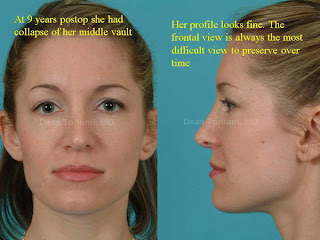Can Dr. Toriumi work with big and wide noses?
Some patients just cannot
have a small nose based on their anatomy, skin thickness, or effects from
previous surgery. In the ideal setting all patients would have whatever sized
nose that they want. Unfortunately, this is not reality.
Patients who have thinner, pliable skin and noses that are larger are more likely to tolerate a significant downsizing of their nose. In these patients, their thinner skin will tend to shrink over time to accommodate the reduction in their nasal cartilage and bone structure. This shrinkage may take many months or even years. Therefore, these patients will likely be unhappy early on, before their swelling subsides and the skin shrinks to accommodate the new nasal structure. If the nose is made too small, the skin may never completely contract and may leave a deformity.
For most rhinoplasty patients Dean Toriumi will perform digital imaging during the initial consultation to demonstrate what he feels is a realistic outcome. Dean will try to make the nose smaller if he feels the skin will accommodate such a change. This requires a great deal of judgment, and Toriumi prefers to make a nice improvement by decreasing the size of ones nose by a safe degree as opposed to making it too small and having the skin droop.
Patients who have thinner, pliable skin and noses that are larger are more likely to tolerate a significant downsizing of their nose. In these patients, their thinner skin will tend to shrink over time to accommodate the reduction in their nasal cartilage and bone structure. This shrinkage may take many months or even years. Therefore, these patients will likely be unhappy early on, before their swelling subsides and the skin shrinks to accommodate the new nasal structure. If the nose is made too small, the skin may never completely contract and may leave a deformity.
For most rhinoplasty patients Dean Toriumi will perform digital imaging during the initial consultation to demonstrate what he feels is a realistic outcome. Dean will try to make the nose smaller if he feels the skin will accommodate such a change. This requires a great deal of judgment, and Toriumi prefers to make a nice improvement by decreasing the size of ones nose by a safe degree as opposed to making it too small and having the skin droop.
Illustrative
patient cases:
The patient shown below had a prominent overprojected asymmetric nasal tip and wide dorsum. In order to create better balance in her nose Dean Toriumi decreased her nasal tip projection. Her preoperative computer imaging showed a larger nose than what was achieved at the time of surgery. Because her skin was relatively thin and redraped well he was able to make her nose smaller than the preoperative computer imaging. Toriumi also narrowed her bridge and straightened her asymmetric nasal tip.
The patient shown below had a prominent overprojected asymmetric nasal tip and wide dorsum. In order to create better balance in her nose Dean Toriumi decreased her nasal tip projection. Her preoperative computer imaging showed a larger nose than what was achieved at the time of surgery. Because her skin was relatively thin and redraped well he was able to make her nose smaller than the preoperative computer imaging. Toriumi also narrowed her bridge and straightened her asymmetric nasal tip.
In following my patients over many years, I have found that the middle vault region (mid portion) of the nose tends to narrow dramatically over time. Patients on whom I operated tended to develop narrowing of the middle vault region over many years. In patients with thinner skin and shorter nasal bones, their middle vault region tended to narrow too much and become pinched years after surgery.
The patient shown below was operated on 9 years ago. She had a bulbous tip and dorsal hump. I performed a dorsal hump reduction and placed spreader grafts. Despite the spreader grafts her middle nasal vault gradually collapsed over many years. The collapse occurred because the patient has thin skin, short nasal bones and long upper lateral cartilages. If this patient had thick skin her deformity would be less prominent. This patient needed thicker spreader grafts or a slight degree of overcorrection of her middle nasal vault to prevent this collapse. By following my patients long term I am able to see these problems and make adjustments in my technique.










No comments:
Post a Comment